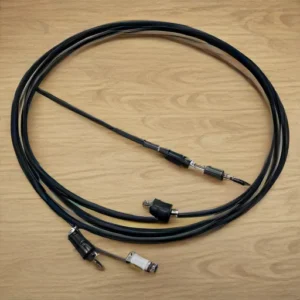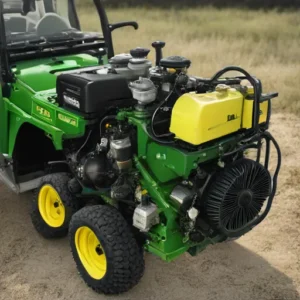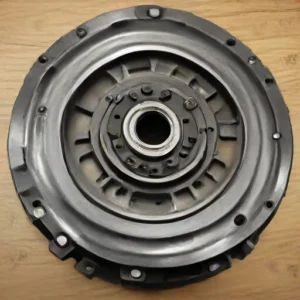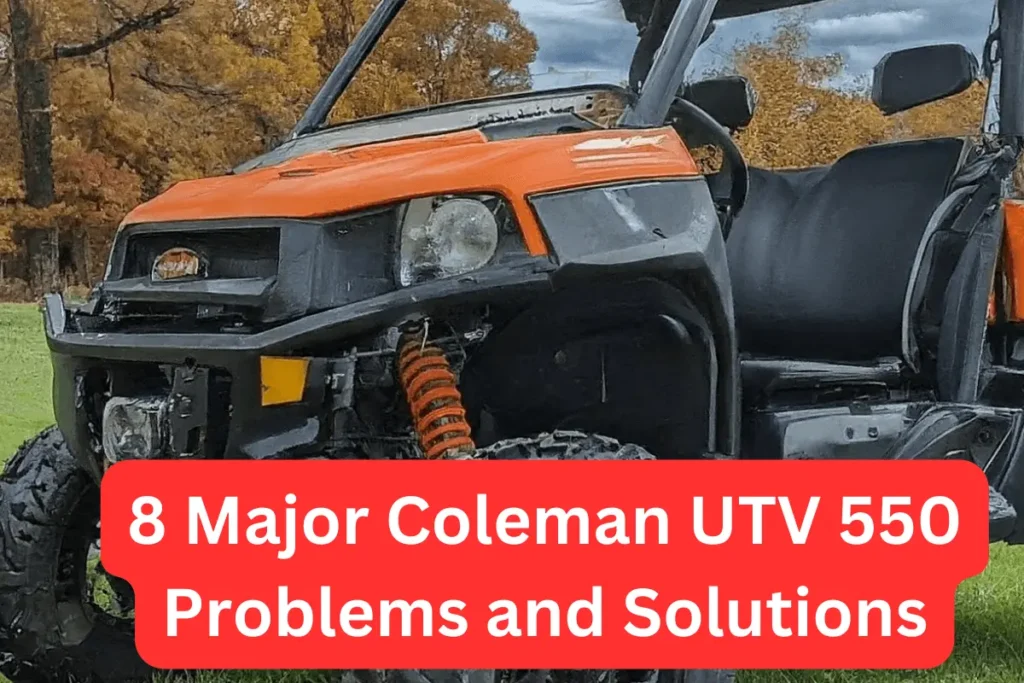The most common John Deere Gator XUV 550 problems are shift cable issues, starting issues, hard to shift, engine idling to fast, clutch issues, brake problems, engine overheating problems, steering issues and throttle problems.
Here I provide the solution so that you can solve these issues if you are a non-technical person.
9 Major John Deere Gator XUV 550 problems
Now we are going to explore the most common problems of John Deere Gator XUV 550 with their easy solutions. Also explore the John Deere Gator 835M issues.
1. Shift Cable Issues

One of the most common issues that owners of the John Deere Gator XUV 550 may face is the failure of the shift cable to engage or disengage gears properly. This can manifest as difficulty in shifting between gears, the inability to shift into certain gears, or the vehicle getting stuck in a particular gear.
Another issue that may arise is the shift cable becoming loose or detached, leading to a loss of control over the vehicle’s transmission. This can be a serious safety concern, especially when operating the Gator XUV 550 in challenging terrains or work environments.
Also explore the offroad vehicles
Causes of Shift Cable Failure
Several factors can contribute to the failure of the shift cable in the John Deere Gator XUV 550. One common cause is wear and tear over time, especially in vehicles that are used in demanding conditions such as off-road driving or heavy-duty work.
Inadequate maintenance and lubrication of the shift cable can also accelerate its deterioration, leading to premature failure.
Additionally, exposure to environmental elements such as moisture, dirt, and debris can compromise the integrity of the cable and its associated components.
Also explore the John Deere Gator 835R issues
Solutions for Shift Cable Failure
When facing issues with the shift cable in your John Deere Gator XUV 550, it is essential to address the problem promptly to ensure the continued safe and efficient operation of your vehicle. Here are some solutions that can help resolve shift cable failure:
- Inspection and Maintenance: Regularly inspect the shift cable for signs of wear, fraying, or damage. Make sure that the cable is properly lubricated according to the manufacturer’s recommendations. Address any issues promptly to prevent further damage.
- Replacement of Shift Cable: If the shift cable is severely damaged or worn out, it may be necessary to replace the cable with a genuine John Deere replacement part. Professional installation is recommended to ensure proper functionality.
- Protective Measures: Consider installing protective covers or guards to shield the shift cable and related components from environmental hazards. This can help prolong the life of the cable and prevent premature failure.
- Professional Service: In cases where the shift cable failure is complex or extensive, seeking the expertise of a certified John Deere technician is advisable. They can diagnose the issue accurately and perform the necessary repairs to restore the functionality of the shift cable.
2. Starting Problems

One of the most common starting problems with the John Deere Gator XUV 550 is a dead battery. Over time, the battery can lose its charge, especially if the vehicle has been sitting unused for an extended period.
In this case, the solution is to recharge or replace the battery. It’s important to check the battery’s voltage and overall condition regularly to avoid unexpected starting issues.
Another common issue is related to the fuel system. If the engine is not getting enough fuel, it may struggle to start or fail to start altogether. This can be caused by a clogged fuel filter or a faulty fuel pump.
Regular maintenance, including replacing the fuel filter at the recommended intervals, can help prevent this issue.
Additionally, ensuring that the fuel tank is filled with clean, high-quality fuel is essential for the proper functioning of the vehicle.
Furthermore, the ignition system plays a crucial role in the starting process. A faulty spark plug or a malfunctioning ignition coil can lead to starting problems.
Regularly inspecting and replacing spark plugs, as well as ensuring that the ignition system is in good working condition, can help prevent these issues.
It’s also important to consider the possibility of electrical problems. Corroded or loose connections, as well as damaged wiring, can impede the starting process.
Regularly inspecting the electrical components and addressing any issues promptly can help maintain the vehicle’s reliability.
Also explore the John Deere Gator 625i issues
3. Hard Shifting Issues

One of the primary reason behind hard shifting problems in the John Deere Gator XUV 550 is inadequate transmission fluid levels or the use of incorrect transmission fluid. Low or dirty transmission fluid can lead to increased friction and improper lubrication, resulting in rough gear changes and potential damage to the transmission components.
Another common cause is clutch-related issues. A worn-out or misadjusted clutch can lead to difficulties in disengaging and engaging the transmission, causing hard shifting and potential gear slippage.
Furthermore, mechanical issues such as worn synchronizers, damaged gears, or linkage problems can also contribute to hard shifting problems in the Gator XUV 550.
Solutions to Address Hard Shifting Problems
Addressing hard shifting problems in the John Deere Gator XUV 550 requires a systematic approach to diagnose and resolve the underlying issues. Here are some effective solutions to consider:
1. Check and Replace Transmission Fluid
Start by checking the transmission fluid levels and condition. Make sure that the fluid is at the recommended level and free from debris or discoloration.
If the fluid appears dirty or low, it’s crucial to drain the old fluid and replace it with the manufacturer-recommended transmission fluid. This simple yet essential maintenance task can significantly improve shifting smoothness and overall transmission performance.
2. Inspect and Adjust the Clutch
Next, it’s important to inspect the clutch system for any signs of wear or misadjustment. A qualified technician can assess the clutch components, including the pressure plate, clutch disc, and release bearing, to determine if any parts require replacement or adjustment.
Proper clutch operation is vital for seamless gear engagement and disengagement, ultimately addressing hard shifting issues.
3. Evaluate Transmission Components
Additionally, a thorough evaluation of the transmission components is essential. This involves inspecting the gears, synchronizers, and linkages for any signs of wear, damage, or misalignment. Replacing worn synchronizers or addressing mechanical issues within the transmission can restore smooth shifting performance in the Gator XUV 550.
4. Professional Diagnosis and Repair
If the hard shifting problems persist despite the aforementioned measures, seeking professional diagnosis and repair from an authorized John Deere service center is highly recommended.
These trained technicians have the expertise and resources to conduct in-depth assessments of the transmission system and implement precise repairs to resolve hard shifting issues effectively.
4. Engine Idling Too Fast

When the engine of your John Deere Gator XUV 550 idles too fast, it can lead to several problems. One of the most immediate issues is the excessive wear and tear on engine components. The increased speed puts additional stress on various parts, leading to premature wear and potential breakdowns.
Furthermore, fast idling can also result in decreased fuel efficiency, as the engine is consuming more fuel than necessary at idle. This not only impacts your operating costs but also contributes to environmental pollution due to increased emissions.
In addition, fast idling can make it challenging to control the vehicle, especially in situations that require precise maneuvering at low speeds. This can pose safety risks for both the operator and others in the vicinity.
Potential Causes of Fast Idling
Several factors can contribute to the engine of your John Deere Gator XUV 550 idling too fast. One common cause is a malfunctioning throttle control system. This can be due to issues with the throttle cable, linkage, or the throttle body itself.
In some cases, a dirty or clogged air filter can disrupt the air-fuel mixture, leading to irregular idling speeds. Additionally, problems with the fuel injection system or carburetor can also result in fast idling.
It’s important to note that mechanical issues such as vacuum leaks, incorrect ignition timing, or a faulty engine sensor can also play a role in causing the engine to idle at a higher speed than normal.
Effective Solutions to Address Fast Idling
When dealing with a John Deere Gator XUV 550 engine idling too fast, it’s essential to implement effective solutions to rectify the issue. One of the first steps is to inspect and clean the throttle body and related components. This can help eliminate any obstructions or build-up that may be causing irregular idling.
Furthermore, checking and replacing the air filter at regular intervals is crucial to maintaining proper air intake and fuel mixture. A clean air filter can significantly contribute to stable idling speeds and overall engine performance.
If the fast idling persists, it’s advisable to have the fuel injection system or carburetor inspected by a qualified technician. They can identify any underlying issues and perform the necessary adjustments or repairs to restore optimal idling speed.
Addressing mechanical issues such as vacuum leaks or ignition timing requires a comprehensive diagnostic approach. Consulting with a certified mechanic who has expertise in servicing John Deere vehicles is essential to accurately diagnose and resolve these complex issues.
5. Engine Overheating

One of the primary reasons for engine overheating in the John Deere Gator XUV 550 is a lack of proper maintenance. Over time, dirt, debris, and other contaminants can accumulate in the cooling system, leading to reduced efficiency in heat dissipation.
Additionally, low coolant levels or a malfunctioning thermostat can also contribute to overheating issues.
Furthermore, operating the vehicle under heavy loads or in extreme environmental conditions can put additional strain on the engine, leading to overheating. It’s essential to recognize these common causes to effectively address the underlying issues.
Effective Solutions to Engine Overheating Problems
- Regular Maintenance: I cannot stress enough the importance of regular maintenance to prevent engine overheating. This includes flushing the cooling system, replacing the coolant at recommended intervals, and ensuring all components are in optimal condition.
- Check Coolant Levels: Keeping a close eye on the coolant levels is crucial. If the levels are consistently low, it may indicate a leak or another underlying issue that needs to be addressed promptly.
- Thermostat Inspection: A malfunctioning thermostat can disrupt the normal flow of coolant, leading to overheating. Have a professional inspect the thermostat and replace it if necessary.
- Avoid Overloading: While the John Deere Gator XUV 550 is a robust vehicle, overloading it can strain the engine and contribute to overheating. Be mindful of the recommended load capacity and avoid exceeding it.
- Environmental Considerations: In extreme heat conditions, take extra precautions such as allowing the engine to cool down periodically and avoiding prolonged operation in high temperatures.
6. Clutch Problems

It’s important to be able to recognize the symptoms of clutch problems in your John Deere Gator XUV 550. Some common signs include:
- Difficulty in shifting gears
- Slipping or jerking during acceleration
- Burning smell from the clutch
- Unusual noises when engaging the clutch
- Decreased engine power and responsiveness
If you notice any of these symptoms while operating your Gator XUV 550, it’s crucial to address the issue promptly to prevent further damage to the vehicle’s clutch system.
Also explore the John Deere Gator High Hours
Potential Solutions for Clutch Problems
When facing clutch problems with your John Deere Gator XUV 550, there are several potential solutions to consider. Here are some steps that owners can take to address clutch issues:
1. Check Clutch Fluid Levels
Low clutch fluid levels can lead to improper clutch engagement and result in performance issues. Owners should regularly inspect the clutch fluid reservoir and ensure that the fluid levels are within the recommended range. If the fluid is low, topping it up with the manufacturer-recommended fluid can help address certain clutch-related issues.
2. Inspect Clutch Cable and Linkage
The clutch cable and linkage play a crucial role in the operation of the clutch system. Over time, these components may experience wear and tear, leading to issues with clutch engagement.
Owners should inspect the clutch cable and linkage for any signs of damage, fraying, or misalignment. Replacing worn-out or damaged components can help restore proper clutch functionality.
3. Adjust Clutch Engagement
In some cases, the clutch engagement may require adjustment to ensure optimal performance. Owners can refer to the vehicle’s manual for instructions on how to adjust the clutch engagement. However, it’s important to exercise caution when making adjustments and seek professional assistance if unsure about the process.
4. Professional Inspection and Maintenance
If the aforementioned steps do not resolve the clutch issues, it may be necessary to seek professional inspection and maintenance from a qualified technician.
A certified John Deere service center or mechanic with expertise in Gator XUV 550 vehicles can diagnose the root cause of the clutch problems and perform the necessary repairs or replacements.
7. Brake Problems

One of the common brake problems that Gator XUV 550 owners may face is brake noise. This can manifest as squeaking, grinding, or squealing sounds when the brakes are applied.
Another issue is reduced brake effectiveness, where the brakes may feel less responsive or take longer to bring the vehicle to a stop. Additionally, brake fluid leaks and brake pedal pulsation are also common problems that can arise in the Gator XUV 550.
Solutions to Brake Problems
When faced with brake noise, it is important to inspect the brake pads and discs for wear. Worn brake pads or discs can lead to noisy braking and should be replaced if necessary.
Additionally, lubricating the contact points of the brake pads can help reduce noise. In the case of reduced brake effectiveness, checking the brake fluid level and ensuring that the brake lines are free from air bubbles or leaks is crucial.
Bleeding the brake system may be necessary to remove any air that has entered the system. Brake fluid leaks should be addressed immediately, and any damaged components should be replaced to prevent further issues.
Lastly, brake pedal pulsation can be caused by warped brake discs, and replacing or resurfacing the discs can help resolve this issue.
8. Steering Problems

One of the most frequently reported issues with the John Deere Gator XUV 550 is stiff or unresponsive steering.
Several factors, including low tire pressure, damaged steering components, or issues with the power steering system, can cause this.
Another common problem is the vehicle pulling to one side, often indicating an alignment issue or uneven tire wear.
Solutions
To address stiff or unresponsive steering:
- Start by checking the tire pressure.
- Ensure all tires are inflated to the recommended pressure levels specified in the owner’s manual.
- If the problem persists, inspect the steering components, such as the tie rods, ball joints, and steering rack, for any signs of damage or wear.
Replacing worn-out parts can significantly improve steering responsiveness.
If your Gator XUV 550 pulls to one side, checking the wheel alignment is crucial. Misalignment can occur due to rough terrain or hitting obstacles. A professional alignment service can correct this issue. Additionally, ensure that your tires have even tread wear. Uneven wear might require tire rotation or replacement.
9. Throttle Problems
Understanding the specific problems with the throttle can help in diagnosing and fixing them:
- Inconsistent Power Delivery: This can be caused by a dirty throttle body, leading to jerky or uneven power.
- Sticking Throttle: Often due to debris or corrosion in the throttle linkage, making it difficult to control the speed.
- Idle Problems: The engine might idle poorly due to incorrect throttle cable tension or a faulty throttle position sensor (TPS).
Solutions
Here are some practical solutions that you can apply to address these throttle problems:
- Cleaning the Throttle Body: Regularly clean the throttle body using a specialized cleaner to ensure smooth air flow and consistent power delivery.
- Inspect and Lubricate Throttle Linkage: Check for any debris or corrosion in the throttle linkage and apply appropriate lubricant to ensure it moves freely.
- Adjust Throttle Cable Tension: Make sure the throttle cable is properly adjusted. If it is too tight or too loose, it can cause idle issues.
- Replace Throttle Position Sensor: If the TPS is faulty, replace it with a new one. This sensor is crucial for providing accurate information to the engine control unit (ECU).
John Deere gator xuv 550 top speed
The John Deere Gator XUV 550 has a top speed of around 28 mph. This makes it ideal for off-road tasks and light recreational use. While not the fastest, its speed is balanced for safety and stability on rough terrain. This Gator is designed for reliability and easy handling, perfect for beginners.
Conclusion:
By reading this guide you can easily get rid from the John Deere gator xuv 550 problems because here I provide the complete details about it.

